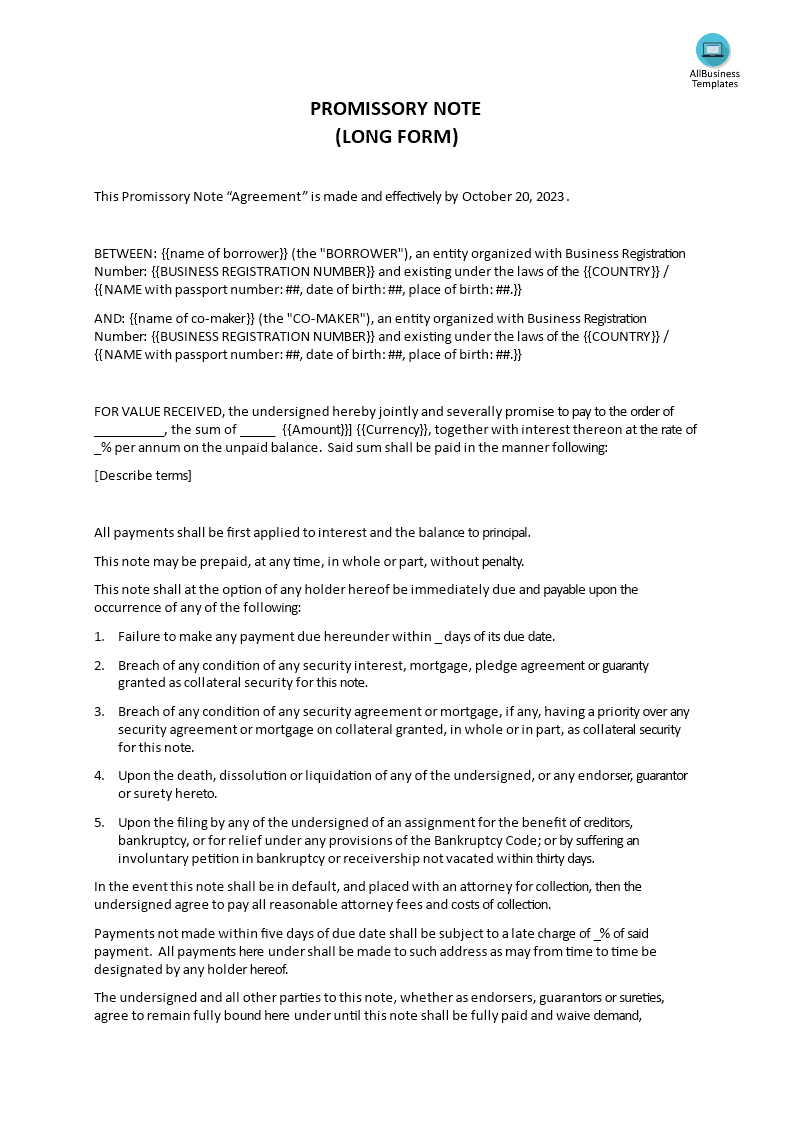Promissory Note long form
Save, fill-In The Blanks, Print, Done!

Download Promissory Note long form
Today: USD 2.99
Download It Now

Available premium file formats:
Microsoft Word (.docx)- This Document Has Been Certified by a Professional
- 100% customizable
- This is a digital download (25.89 kB)
- Language: English
- You will receive a link to download the file as soon as your payment goes through.
- We recommend downloading this file onto your computer.
How to write a Promissory Note long form? How is a long-term promissory note different from a short-term promissory note? Our promissory note templates are designed to meet your long-term needs. Download our template now which is professionally drafted and easy to follow.
A long-term promissory note is a financial document that represents a legally binding promise to repay a loan or debt over an extended period, typically exceeding one year. This type of promissory note outlines the terms and conditions of the loan, including the principal amount borrowed, the interest rate, the repayment schedule, and any other relevant terms. Long-term promissory notes are commonly used for significant loans, such as real estate mortgages, business loans, or large personal loans, where the repayment period extends well beyond the short term.
Key characteristics of a long-term promissory note include:
- Extended Repayment Period: The primary characteristic of a long-term promissory note is that it establishes a repayment period that extends for several years, often ranging from 5 to 30 years or more.
- Principal Amount: It specifies the initial amount borrowed, known as the principal, which is typically a significant sum.
- Interest Rate: The note includes the annual interest rate or the rate at which interest accrues on the outstanding balance. Long-term loans may have fixed interest rates (which remain constant throughout the loan term) or variable interest rates (which can change over time based on market conditions or a predetermined index).
- Repayment Schedule: The document outlines the repayment schedule, including the frequency of payments (e.g., monthly, quarterly, annually), the amount of each payment, and the due dates for each installment.
- Maturity Date: The long-term promissory note specifies the maturity date, which is the date by which the borrower is required to repay the entire outstanding balance, including principal and accrued interest.
- Collateral (if applicable): If the loan is secured by collateral, such as real estate or personal assets, the note may include details about the collateral, its value, and the lender's rights in case of default.
- Prepayment Options: Some long-term promissory notes allow the borrower to make prepayments (pay off the loan before the maturity date) without incurring penalties, while others may have restrictions or prepayment penalties.
- Default and Remedies: The document typically outlines the consequences of default, including late fees, collection efforts, and the lender's rights to take legal action if the borrower fails to meet their obligations.
- Governing Law: It specifies the state or jurisdiction whose laws will govern the promissory note and any disputes related to it.
- Signatures and Dates: The long-term promissory note is signed and dated by both the borrower and the lender, indicating their agreement to the terms and conditions.
Long-term promissory notes are legally binding contracts, and it is essential for both parties to fully understand and comply with the terms outlined in the document. Borrowers should carefully review the terms and consider seeking legal or financial advice before entering into such agreements, especially given the long-term nature of the commitments involved.
A long-term promissory note and a short-term promissory note differ primarily in their loan duration and associated repayment terms:
Long-Term Promissory Note:
Short-Term Promissory Note:
- Loan duration typically exceeds one year.
- Used for significant loans like mortgages and business financing.
- Involves larger principal amounts due to an extended repayment period.
- May have fixed or variable interest rates.
- Features structured repayment schedules with monthly or annual payments.
- Typically used for long-term financial endeavors.
Short-Term Promissory Note:
- Loan duration is usually less than one year.
- Used for smaller loans, often for immediate financial needs.
- Involves smaller principal amounts suited for quick repayment.
- Often has higher interest rates due to the shorter term.
- Requires more frequent payments (weekly, biweekly, or monthly).
- Commonly used for short-term cash flow issues or emergencies.
These differences impact factors like interest rates, payment schedules, and the types of financial needs they address.
Download this professional Promissory Note long-form template now!
For more business templates? Just browse through our database and website! You will have instant access to thousands of free and premium business templates, legal agreements, documents, forms, letters, reports, plans, resumes, etc., which are all used by professionals in your industry. All business templates are ready-made, easy to find, wisely structured and intuitive.
DISCLAIMER
Nothing on this site shall be considered legal advice and no attorney-client relationship is established.
Leave a Reply. If you have any questions or remarks, feel free to post them below.
Related templates
Latest templates
Latest topics
- Excel Templates
Where do I find templates for Excel? How do I create a template in Excel? Check these editable and printable Excel Templates and download them directly! - GDPR Compliance Templates
What do you need to become GDPR compliant? Are you looking for useful GDPR document templates to make you compliant? All these compliance documents will be available to download instantly... - Google Docs Templates
How to create documents in Google Docs? We provide Google Docs compatible template and these are the reasons why it's useful to work with Google Docs... - IT Security Standards Kit
What are IT Security Standards? Check out our collection of this newly updated IT Security Kit Standard templates, including policies, controls, processes, checklists, procedures and other documents. - Letter Format
How to format a letter? Here is a brief overview of common letter formats and templates in USA and UK and get inspirited immediately!
cheese
